HD4RES v2
HD4RES v2 Jonas.VanBussel Thu, 08/31/2023 - 09:34General description of the application HD4RES v2
General description of the application HD4RES v2What?
The component HD4RES v2 can be seen as a monitoring tool that provides researchers who are managing a research project on the healthdata.be platform a set of (non scientific) operational reports. The first reports foreseen by healthdata.be are:
- Count of study records in the different components of healthdata.be (HD4DP v2 Local, HD4DP v2 web, HD DWH Staging, HD DWH CDW, HD DWH Exploitation, ...)
- Count of unique study subjects in the different components of healthdata.be
- Count of unique study subjects in multiple studies available at the healthdata.be platform
- List of data providers (organisations) for the research project
- List of data providers (individuals) for the research project
- List of data users (organisations) on the healthdata.be platform
- List of data users (individuals) on the healthdata.be platform
- Status of all technical components of healthdata.be used for the research project
- List of incidents related to the research project
- List of requests related to the research project
In its current form, HD4RES v2 is a collection of data tables accessible via the SAS eGuide component at the data warehouse of healthdata.be. It is thus integrated in the core of the research environment. In a next stage, the data tables will be visualized using the SAS Visual Analytics component at the data warehouse. While a predefined set of visualizations will be offered by healthdata.be, the researcher will be able to create and execute workflows for interactive reporting and exploration.
In contrast with HD4RES v1, HD4RES v2 is not a communication tool with the data providers to verify the quality of the submitted data. This functionality is now only available in the Data Validation Tool of the healthdata.be platform.
Who?
The HD4RES v2 component is only accessible by researchers formally involved in the management of a research project on the healthdata.be platform.
Where?
The component HD4RES v2 is part of the data warehouse environment of the healthdata.be platform.
When?
The HD4RES v2 component is available as of Thursday 20th of October 2022 and can be accessed 24/7/365.
How?
This documentation is being updated regularly. We try to provide as correct, complete and clear as possible information on these pages. Nevertheless, if you see anything in the documentation that is not correct, does not match your experience or requires further clarification, please create a request (type : request for information) via our portal (https://sciensano.service-now.com/sp) or send us an e-mail via support.healthdata@sciensano.be to report this documentation issue. Please, do not forget to mention the URL or web address of the page with the documentation issue. We will then adjust the documentation as soon as possible. Thank you!HD4RES v1 versus HD4RES v2
HD4RES v1 versus HD4RES v2HD4RES v1
HD4RES v1 is an application developed by healthdata.be Sciensano that allows the manager of a specific data collection project to communicate with the data provider without knowing the identification of the patient. Data are sent to the central HD4RES application via eHealth. A mechanism of encryption is put in place assuring that nobody has access to the patient identifier and medical information except the data provider.

Position of HD4RES v1 (red block) in Architecture 1.0
The researcher receives the data in the software component HD4RES where he/she can monitor the status of his/her data collection, check the data and, if necessary, ask additional questions to the data provider, e.g. regarding the quality of the data.
To this end, healthdata.be sends a message back to the data provider via ehBox coding. This contains the encrypted data, together with the medical-scientific data that are encrypted with respect to the data provider. eHealth-platform takes care of the decryption of the encrypted data and delivers the data to the data provider.
The challenge for healthdata.be in Architecture 1 was that all healthcare organizations and all healthcare professionals should be able to provide data in a structured and encoded way to the researcher. The records collected from the data providers could follow many itineraries, making monitoring a complex matter.
HD4RES v2
The main objective of HD4RES v2 is to simplify HD4RES.
Like in Architecture 1.0, the researcher will be able to monitor the Architecture 2.0 dataflow end-to-end. The feedback loop, however, will be taken out of HD4RES v2 and will be integrated into the Quality Control tool. The application HD4RES as such disappears and becomes a block SAS eGuide in DWH that takes over that function.
HD4RES v2 has now become a mere monitoring tool offering researchers an overview and status of all (external and internal) dataflows for his/her project only, as well as an overview of all HD4DP v2 and healthstat.be accounts for his/her project only.
Equally, the dataflow from ServiceNow on incidents and requests is only made visible to researchers for projects in which they are involved.
This documentation is being updated regularly. We try to provide as correct, complete and clear as possible information on these pages. Nevertheless, if you see anything in the documentation that is not correct, does not match your experience or requires further clarification, please create a request (type : request for information) via our portal (https://sciensano.service-now.com/sp) or send us an e-mail via support.healthdata@sciensano.be to report this documentation issue. Please, do not forget to mention the URL or web address of the page with the documentation issue. We will then adjust the documentation as soon as possible. Thank you!Position of HD4RES v2 in HD Architecture 2.0
Position of HD4RES v2 in HD Architecture 2.0The application HD4RES v2 is one of the components of the broader data collection and management architecture managed by the healthdata.be service of Sciensano. Below you can find a high level view of that data collection and management architecture (version 2). The HD4RES v2 component (red block) is part of the datawarehouse environment of healthdata.be.
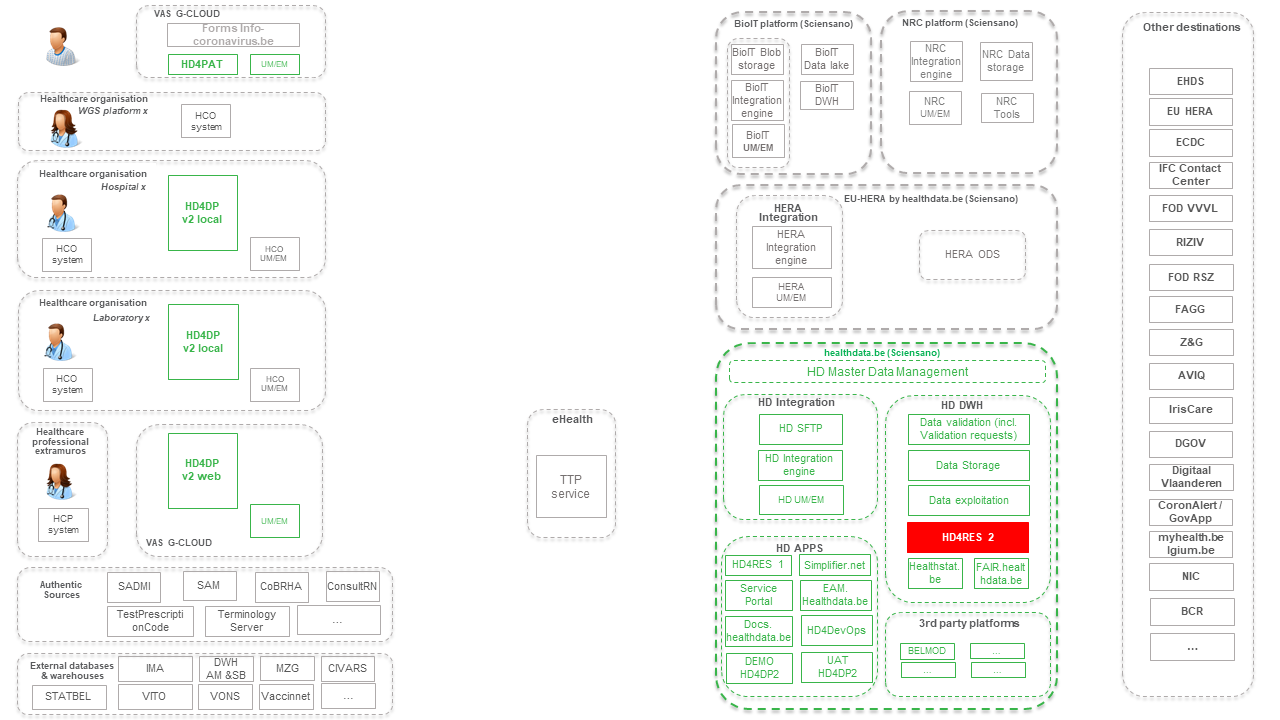
This documentation is being updated regularly. We try to provide as correct, complete and clear as possible information on these pages. Nevertheless, if you see anything in the documentation that is not correct, does not match your experience or requires further clarification, please create a request (type : request for information) via our portal (https://sciensano.service-now.com/sp) or send us an e-mail via support.healthdata@sciensano.be to report this documentation issue. Please, do not forget to mention the URL or web address of the page with the documentation issue. We will then adjust the documentation as soon as possible. Thank you!Dataflow description of the application HD4RES v2
Dataflow description of the application HD4RES v2The component HD4RES v2 is a monitoring tool on several operational processes relevant for the researcher. As a result, HD4RES v2 receives data from very diverse applications and environments, within and outside the healthdata.be platform.
Count of study records in the different components of healthdata.be
There are many different components of healthdata.be that contain study records. Outside the healthdata.be platform, study records are available in :
- HD4DP v2 Local
- HD4DP v2 web
- HD4Patient
- HERA platform
- BioIT platform (Integration)
- NRC platform (Integration)
These external components are monitored by a tool (HD4DevOps) used for the real time monitoring of the technical status and operations within these components. The HD4DevOps component also collects counts (aggregated and thus anonymously) of records in these external components. The monitoring by this component, however, is not possible in HD4RES v1 Local since this component is not configured to gather data in the new Architecture 2 setup.
Study records are also available in following internal components of the healthdata.be platform:
- HD Integration
- HD DWH Staging
- HD DWH CDW
- HD DWH Exploitation
The HD4RES2 component collects on a daily basis the counts (aggregated and thus anonymously) of records in these internal components and consolidates them with the counts collected by HD4DevOps component.
The publication of the Count of study records in the different components of healthdata.be is currently under development and thus not yet available in HD4RES v2.Count of unique study subjects in the different components of healthdata.be
There are many different components of healthdata.be that contain information about the study subjects (either nominatively or pseudonomized). Outside the healthdata.be platform, this information is available in :
- HD4DP v2 Local
- HD4DP v2 web
- HD4Patient
- HERA platform
- NRC platform (Integration)
These external components are monitored by a tool (HD4DevOps) used for the real time monitoring of the technical status and operations within these components. The HD4DevOps component also collects counts (aggregated and thus anonymously) of unique study subjects in these external components. The monitoring by this component, however, is not possible in HD4RES v1 Local since this component is not configured to gather data in the new Architecture 2 setup.
Study records are also available in following internal components of the healthdata.be platform:
- HD Integration
- HD DWH Staging
- HD DWH CDW
- HD DWH Exploitation
The HD4RES2 component collects on a daily basis the counts ( aggregated and thus anonymously) of unique study subjects in these internal components and consolidates them with the counts collected by HD4DevOps component.
The publication of the Count of unique study subjects in the different components of healthdata.be is currently under development and thus not yet available in HD4RES v2.Count of unique study subjects in multiple studies available at the healthdata.be platform
The publication of the Count of unique study subjects in multiple studies available at the healthdata.be platform is currently under development and thus not yet available in HD4RES v2.List of data providers (organisations) for the research project
The publication of the list of data providers (organisations) for the research project is currently under development and thus not yet available in HD4RES v2.List of data providers (individuals) for the research project
The publication of the List of data providers (individuals) for the research project is currently under development and thus not yet available in HD4RES v2.List of data users (organisations) on the healthdata.be platform
The publication of the list of data users (organisations) on the healthdata.be platform is currently under development and thus not yet available in HD4RES v2.List of data users (individuals) on the healthdata.be platform
The publication of the list of data users (individuals) on the healthdata.be platform is currently under development and thus not yet available in HD4RES v2.Status of all technical components of healthdata.be used for the research project
There are many different components managed by healthdata.be both inside and outside the healthdata.be platform:
- HD4DP v2 Local
- HD4DP v2 web
- HD4Patient
- HERA platform
- BioIT platform (Integration)
- NRC platform (Integration)
- HD Integration
- HD DWH Staging
- HD DWH CDW
- HD DWH Exploitation
- HD MDM
- healthstat.be
- fair.healthdata.be
- eam.healthdata.be
- docs.healthdata.be
These components are monitored by a tool (HD4DevOps) used for the real time monitoring of the technical status and operations within these components. The HD4DevOps component collects information like availability and performance of these services.
The HD4DevOps component provides the availability statistics to the HD4RES2 component so that they are available for the researchers.
The publication of the status of all technical components of healthdata.be used for the research project is currently under development and thus not yet available in HD4RES v2.List of incidents related to the research project
The healthdata.be service (Sciensano) processes each incident report according to a standard operating procedure (SOP). To submit an incident related to projects and applications in production and facilitated or managed by healthdata.be, users create a ticket in the HD Service and Support portal.
Healthdata.be uses the application ServiceNow for its service and support portal. This application is provided in an external public cloud environment. Healthdata.be extracts on a daily basis all incidents recorded in it's portal, and integrates this information in the data warehouse of the healthdata.be platform. On a daily basis, an extract is published in HD4RES v2.
List of requests related to the research project
The healthdata.be service (Sciensano) processes each request according to a standard operating procedure (SOP). To submit an request related to projects, applications and services, users create a ticket in the HD Service and Support portal.
Healthdata.be uses the application ServiceNow for its service and support portal. This application is provided in an external public cloud environment. Healthdata.be extracts on a daily basis all requests recorded in it's portal, and integrates this information in the data warehouse of the healthdata.be platform. On a daily basis, an extract is published in HD4RES v2.
The publication of the list of requests related to a research project is currently under development and thus not yet available in HD4RES v2.This documentation is being updated regularly. We try to provide as correct, complete and clear as possible information on these pages. Nevertheless, if you see anything in the documentation that is not correct, does not match your experience or requires further clarification, please create a request (type : request for information) via our portal (https://sciensano.service-now.com/sp) or send us an e-mail via support.healthdata@sciensano.be to report this documentation issue. Please, do not forget to mention the URL or web address of the page with the documentation issue. We will then adjust the documentation as soon as possible. Thank you!How to request an account for HD4RES v2
How to request an account for HD4RES v2To request access to the component HD4RES v2 of the healthdata.be platform, you first need to log in to the HD Service and Support portal. This portal is available via following URL: https://sciensano.service-now.com/sp
After the log in step, you will arrive at the main page of the portal.
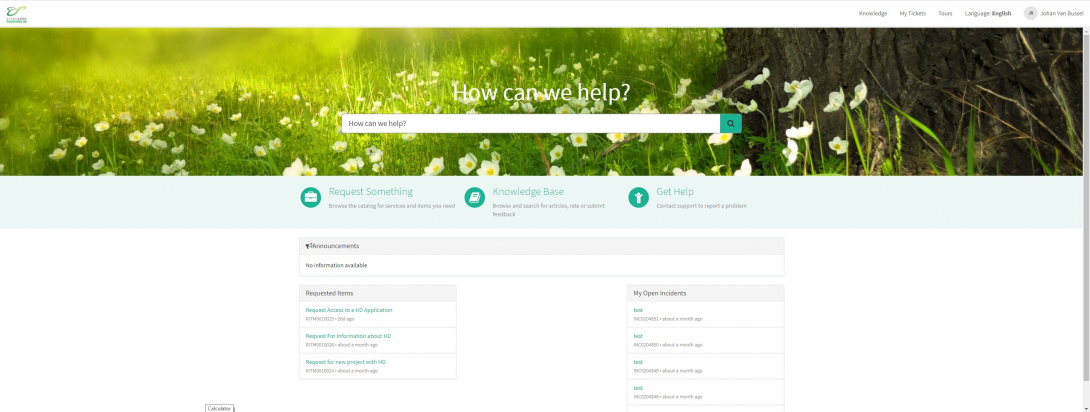
On the main page, you have to select "Request Something"

A new page with the titles of the different types of requests will appear.
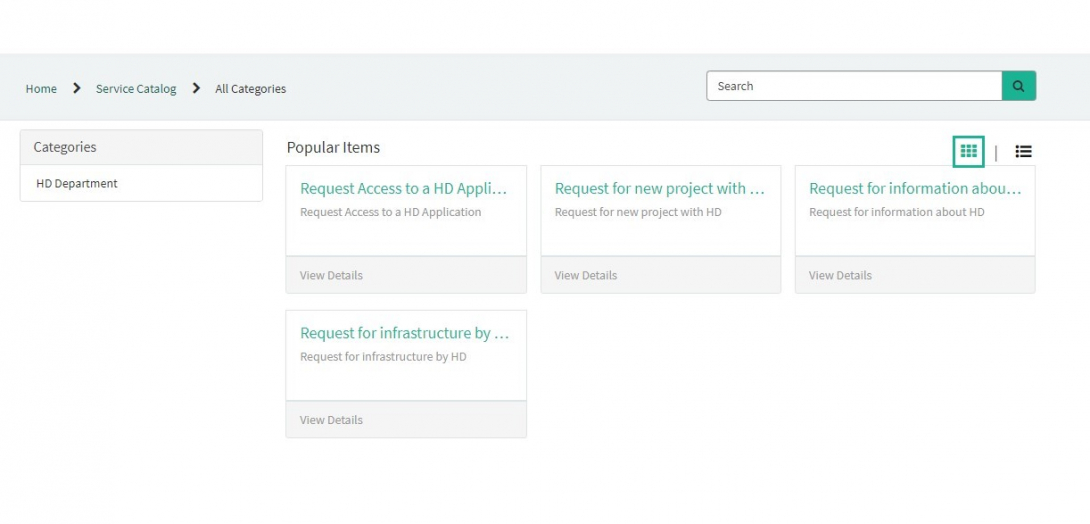
Select the box "Request Access to a HD Application".

A new page with the titles of the Request Access to a HD Application will appear.
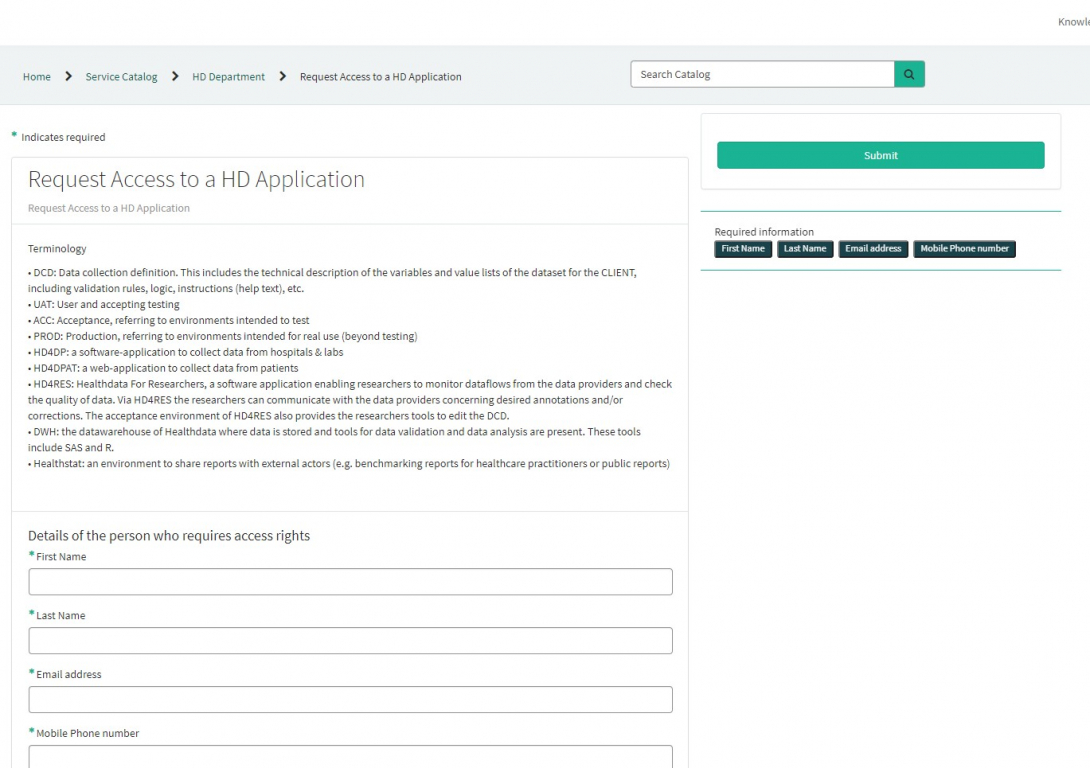
You can now document your incident or problem by providing following information:
Please provide the details of the person who requires access rights: First Name, Last Name, Email address, Mobile Phone number.
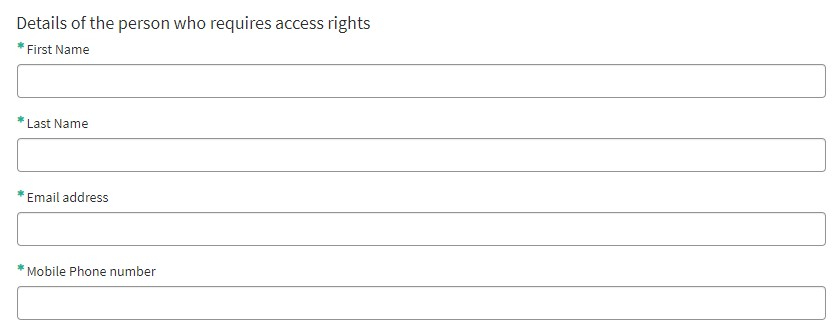
Please select the project for which access rights are required:

Please indicate for which applications access rights are required:
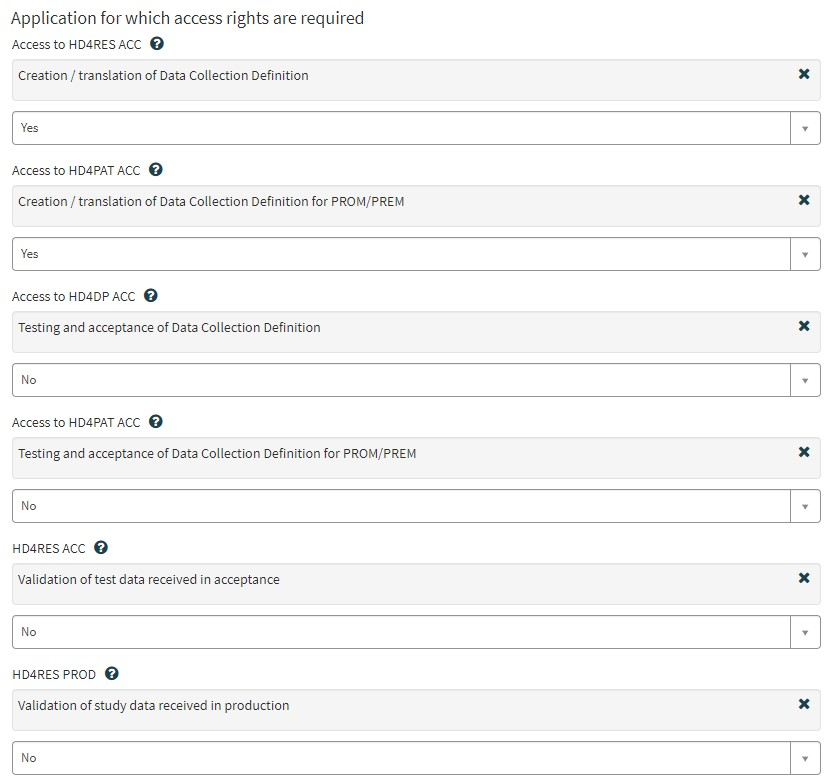
Please indicate whether the project already obtained an authorization from the information Security Committee Social Security & Health?

Please provide the period for which access is requested:

You can optionally provide specific remarks regarding the access request:

If available, please upload additional documents relevant for this request for access
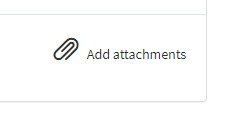
On the right side of the form, the required information elements of the Request form are listed. When these fields are completed, these field names will disappear in the "required information" box.

Only if all required fields are completed , a form can be submitted, by pressing the green "Submit" button.

If not all required fields were completed, a warning message will appear on top of the form.

Also, the missing required fields will be highlighted in green.
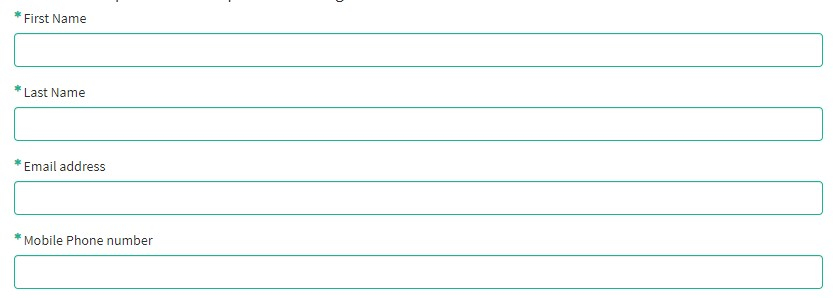
When the request form was successfully submitted, an overview of your submission will appear in an new screen.
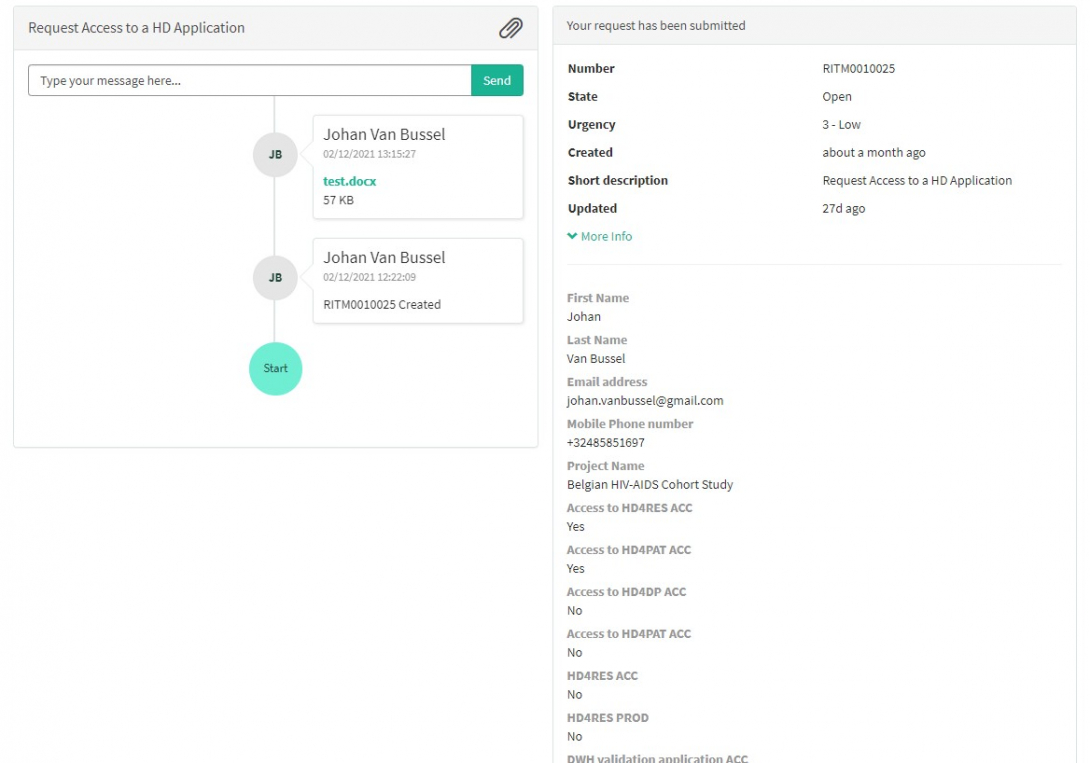
On the right of the screen, you will find the details , including the Request number.

On the left of the screen, you will find a timeline of the handling your request, starting with your creation.
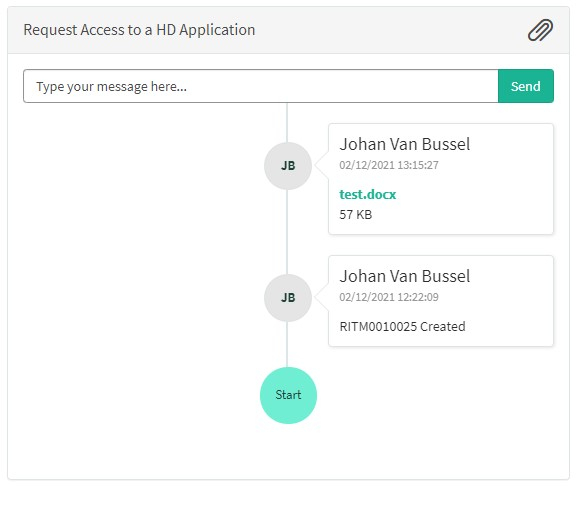
How to access HD4RES v2
How to access HD4RES v2Follow the required steps underneath to get access to HD4RES v2.
Login into the healthdata platform
The healthdata platform is accessible through website https://remote.healthstat.be
Login using the received user credentials:
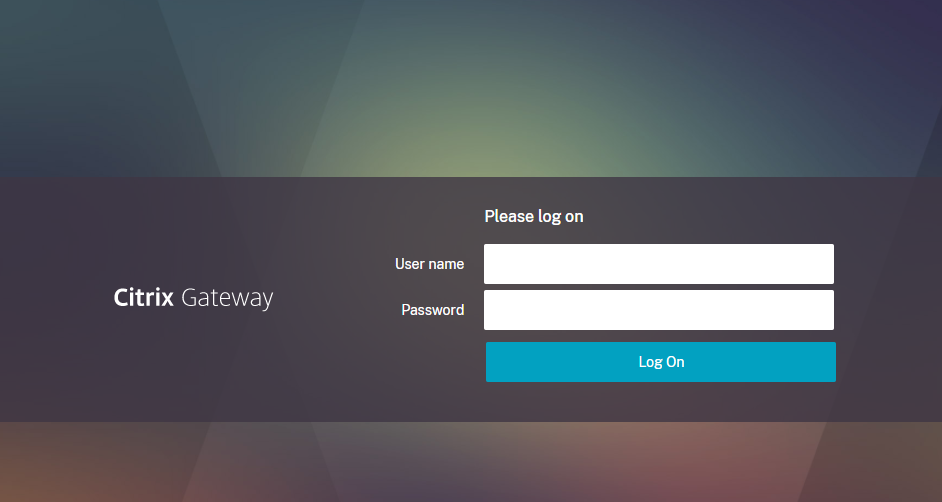
During the login process an SMS Passcode is received on your mobile phone (from 8645), enter this SMS Passcode in the next screen:

* The PASSCODE will also be send to the e-mail address if not entered in the screen within 2 minutes.
Start the SAS Enterprise Guide application
After providing the PASSCODE, install the Citrix Receiver by clicking on ‘Detect Receiver’:
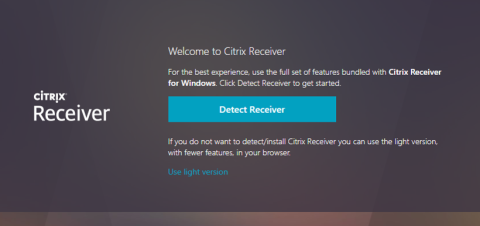
* This step will only appear upon the initial setup.
Selecting ‘APPS’ from the top menu displays the available applications:
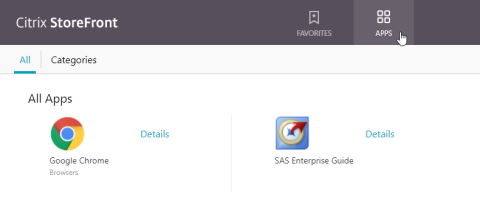
Click on the ‘SAS Enterprise Guide’ icon to start the application:

Open the data table
In SAS Enterprise Guide, the data table is accessible via the ‘Servers’ window, located at the bottom left.
Open the path Servers >> SASAppRES >> Libraries >> HD4RES2
The tables currently stored in the library are:
- V_HDM_SNOW_INCDNT (incident life-cycle)
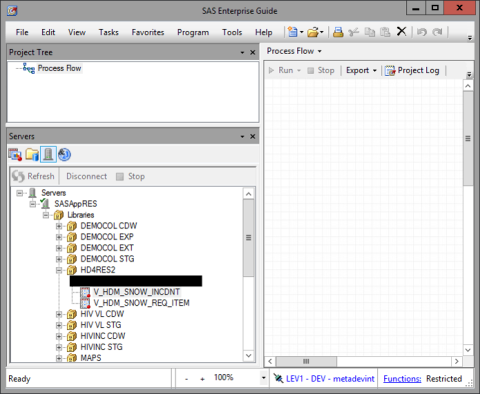
Open the data table by double clicking its name:

Change the column width
Extend the column width if needed (similar to Excel):
Put the cursor on the right side of the column title cell, move the cursor to the appropriate width, or double-click to extend to max width:
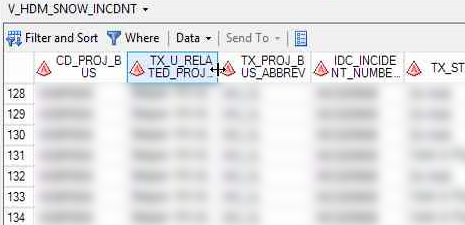
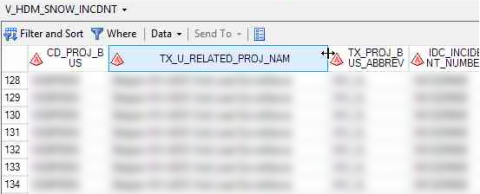
Querying the table
On the top left of the table you’ll have point-and-click interface to query the table: Filter and Sort

Exit the table
To exit the table right close button (‘X’) at the top right corner of the table.

Close the SAS Enterprise Guide application
Upon finishing the visualization or querying you can close the SAS Enterprise Guide application.
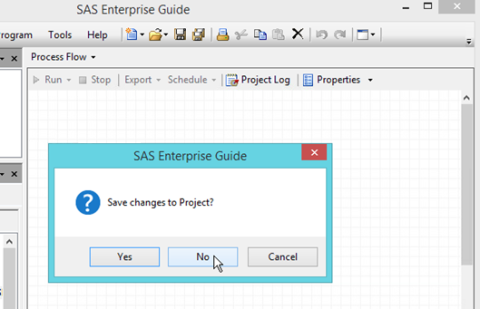
This documentation is being updated regularly. We try to provide as correct, complete and clear as possible information on these pages. Nevertheless, if you see anything in the documentation that is not correct, does not match your experience or requires further clarification, please create a request (type : request for information) via our portal (https://sciensano.service-now.com/sp) or send us an e-mail via support.healthdata@sciensano.be to report this documentation issue. Please, do not forget to mention the URL or web address of the page with the documentation issue. We will then adjust the documentation as soon as possible. Thank you!HD4RES v2 Data tables
HD4RES v2 Data tablesIn its current form, HD4RES v2 is a collection of data tables accessible via the SAS eGuide component at the data warehouse of healthdata.be. It is thus integrated in the core of the research environment. In a next stage, the data tables will be visualized using the SAS Visual Analytics component at the data warehouse. While a predefined set of visualizations will be offered by healthdata.be, the researcher will be able to create and execute workflows for interactive reporting and exploration.
The data tables are not created for each research project separately. HD4RES v2 offers a view based on the master data table on which Row-Column Access Control (RCAC) has been applied to grant access to the researcher to only the records related to his/her project.
The following data tables are foreseen by healthdata.be:
List of incidents
List of incidentsThe healthdata.be service (Sciensano) processes each incident report according to a standard operating procedure (SOP). A public version of this SOP "HD Incident Management Process" is also available on this portal docs.healthdata.be.
To submit an incident related to projects and applications in production and facilitated or managed by Sciensano's healthdata.be service, users can submit a ticket in the HD Service and Support portal.
The researchers have access to the list of incidents related to their project. This list is available in a data table in HD4RES v2.
In SAS Enterprise Guide, the data table is accessible via the ‘Servers’ window, located at the bottom left.
First open the following path Servers >> SASAppRES >> Libraries >> HD4RES2
Then, open the following table "V_HDM_SNOW_INCDNT" (incident life-cycle)
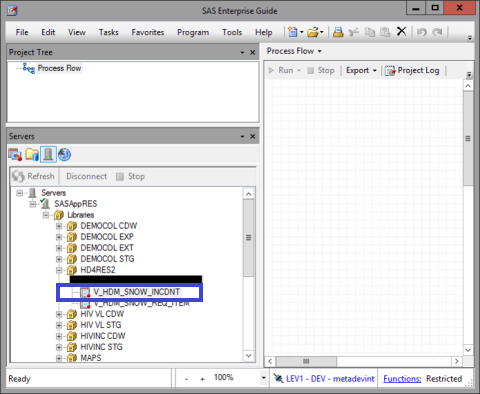
This data table contains the following fields:
| SNOW db field | HD4RES2 column names | Description |
|---|---|---|
| Number | IDC_INCIDENT_NUMBER | Unique number that is created once the incident is submitted (INCxxxxxx) |
| State | TX_STATE | The state in which the incident is at that moment : - New : the ticket is not handled yet - Work in progress : incident is being worked on - On hold : the IT-colleague is waiting for info from another party to continue - Resolved : the incident is resolved. The caller can reopen the incident if not satisfied, within 14 days. - Closed : ticket cannot be reopend anymore |
| Caller | TX_CALLER_ID | The person who has submitted the incident |
| Service | T_U_SVC | The projectname on which the incident is created. Reflects on incidents opened before January 14, 2022. After this date, this field is replaced by the field 'Related Project Name' |
| Category | TX_CAT | The category to which the incident is related (data transfer, infrastructure, application, account, other) |
| Subcategory | TX_SUBCATEGORY | Depending on the category, the type of subcategory will appear that has been chosen. For example : if categroy=application, the list of applications will appear |
| Related Project Name | TX_U_RELATED_PROJ_NAM | The name of the project (full name, abbreviation and projectcode) |
| Opened | DT_OPENED_AT | The date and time when the incident was opened |
| Updated | DT_SYS_UPD_ON | The date and time when the incident was last updated with comments, change of state, … |
| Short description | TX_SHORT_DESC | A short description of the incident |
| Customer Communication | TX_COMMENTS | Communication that has been sent to or received from the caller |
| Organisation | TX_COMP | The organization to which the caller belongs, if filled in in the profile of the caller |
| Assignment group | TX_ASSIGNMENT_GR | The team that is handling the incident. The person of this team that works on the incident, is visible in the portal. |
| Due date | DT_DUE_DATE | The person working on the incident can plan his work by filling in this field. |
| --none-- | CD_PROJ_BUS | The internal project business code (HDBPxxxx) |
| --none-- | TX_PROJ_BUS_ABBREV | Project business abbreviation |
This documentation is being updated regularly. We try to provide as correct, complete and clear as possible information on these pages. Nevertheless, if you see anything in the documentation that is not correct, does not match your experience or requires further clarification, please create a request (type : request for information) via our portal (https://sciensano.service-now.com/sp) or send us an e-mail via support.healthdata@sciensano.be to report this documentation issue. Please, do not forget to mention the URL or web address of the page with the documentation issue. We will then adjust the documentation as soon as possible. Thank you!List of requests
List of requestsThe healthdata.be service (Sciensano) processes each request according to a standard operating procedure (SOP). A public version of this SOP "HD Request Management Process" is also available on this portal docs.healthdata.be.
To submit a request related to projects and applications in production and facilitated or managed by Sciensano's healthdata.be service, users can submit a ticket in the HD Service and Support portal.
The researchers have access to the list of requests related to their project. This list is available in a data table in HD4RES v2.
In SAS Enterprise Guide, the data table is accessible via the ‘Servers’ window, located at the bottom left.
First open the following path Servers >> SASAppRES >> Libraries >> HD4RES2
Then, open the following table "V_HDM_SNOW_REQ_ITEM" (incident life-cycle)
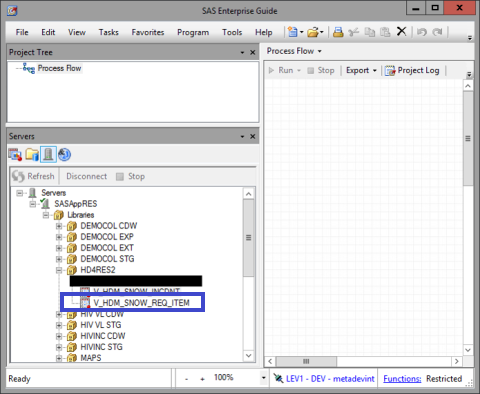
This data table contains the following fields:
| SNOW db field | HD4RES2 column names | Description |
|---|---|---|
| Number | IDC_REQ_ITEM_NUMBER | Unique number that is created once the request is submitted (RITMxxxxxx) |
| State | TX_STATE | The state in which the request is at that moment: - Open: ticket is open but has not yet been assigned to a group to begin work - Work in progress: ticket is being worked on - Pending: the ticket has been placed on-hold and is awaiting action before work can recommence - Closed complete: ticket has been closed and the work has been completed - Closed incomplete: ticket has been closed and the work has not been completed - Closed skipped: ticket has been closed and no work was carried out |
| Caller | TX_REQD_FOR | The person who has submitted the request |
| Category | TX_CAT_ITEM | The category to which the incident is related (Access to a HD Application, Information about HD, Infrastructure by HD, New project with HD, Request Access to a HD Application, Request for information about HD, Request for infrastructure by HD, Request for new project with HD) |
| Related Project Name | TX_U_RELATED_PROJ_NAM | The name of the project (full name, abbreviation and projectcode) |
| Opened | DT_OPENED_AT | The date and time when the request was opened |
| Updated | DT_SYS_UPD_ON | The date and time when the request was last updated with comments, change of state, … |
| Short description | TX_SHORT_DESC | A short description of the request. As from the 22th of December 2022 the field reflects the appropriate request short description. |
| Describe the information you need | TX_DESC | A detailed description of the request. As from the 22th of December 2022 the field reflects the appropriate request description. |
| Customer Communication | TX_COMMENTS | Communication that has been sent to or received from the caller |
| Organisation | TX_COMP | The organization to which the caller belongs, if filled in in the profile of the caller |
| Assignment group | TX_ASSIGNMENT_GR | The team that is handling the incident. The person of this team that works on the incident, is visible in the portal. |
| Due date | DT_DUE_DATE | The person working on the request can plan his work by filling in this field. |
| --none-- | CD_PROJ_BUS | The internal project business code (HDBPxxxx) |
| --none-- | TX_PROJ_BUS_ABBREV | Project business abbreviation |
Count of study records
Count of study recordsThis data table is currently in development by the healthdata.be team.
This documentation is being updated regularly. We try to provide as correct, complete and clear as possible information on these pages. Nevertheless, if you see anything in the documentation that is not correct, does not match your experience or requires further clarification, please create a request (type : request for information) via our portal (https://sciensano.service-now.com/sp) or send us an e-mail via support.healthdata@sciensano.be to report this documentation issue. Please, do not forget to mention the URL or web address of the page with the documentation issue. We will then adjust the documentation as soon as possible. Thank you!Count of unique study subjects
Count of unique study subjectsIntroduction
The purpose of the data table described below is to provide an up-to-date and end-to-end view on the operational dataflow of their project. The obtained metrics on the number of study records and unique study subjects consolidated on a daily base in the HD4RES2 application aims to fulfill this requirement.
Data table: V_HDM_REC_SUBJ_CNT
The researchers have access to a view on the number of study records and unique study subject related to their project. Those figures are available in the data table V_HDM_REC_SUBJ_CNT in HD4RES2 application.
In SAS Enterprise Guide, the data table is accessible via the ‘Servers’ window, located at the bottom left.
First open the following path Servers >> SASAppRES >> Libraries >> HD4RES2
Then, open the following table "V_HDM_REC_SUBJ_CNT"
This data table contains the following fields:
| Requested | FieldName | Description |
|---|---|---|
| HDBP_code | CD_PROJ_BUS | HD internal business project code (HDBPxxxx) |
| HDBP_name | TX_PROJ_BUS_NAME | Project business name |
| HDBP_abbreviation | TX_PROJ_BUS_ABBREV | Project business abbreviation |
| HCO_NIDHICode | TX_DATA_PROV_VAL | NIDHI data provider code |
| HCO_name | TX_DATA_PROV_NAME | NIDHI data provider name |
| HD4DP_MASTER_CHILD | (not yet implemented) | HD4DP user type (technically) of the Health Care Organisation: 'Master' = Data provider has his own instance of HD4DP2 'Child' = Data provider uses the HD4DP instance of a Master |
| HD4DP_MASTER_HCO_NIDHICode | (not yet implemented) | Master NIDHI data provider code |
| HD4DP_MASTER_HCO_name | (not yet implemented) | Master NIDHI data provider name |
| HD_ARCH | (not yet implemented) | |
| HD_ARCH_component | TX_ARCH_COMPONENT | Database component/DWH layer |
| HD4DP_record_status | (not yet implemented) | |
| Count_Date | D_COUNT | Datepart of the metrics calculation made at the end of the day |
| Count (records) | MS_RECS | Count of the total number of study records |
| Count_New (records) | MS_NEW_RECS | New number of study records as from previous date and time |
| Count (subjects) | MS_UNQ_SUBJ | Count of unique study subject/patient |
| Count_New (subjects) | MS_NEW_UNQ_SUBJ | New number of study subject/patient as from previous date and time |
Reference table: V_HDM_MAP_TBL_PROJ
As business projects/data collections often led to the creation of several data tables the figures are resulting from the consolidation of the most representative business project data tables. Consequently those data tables must be treated with respect to their own functional and structural properties.
To this end, researchers may consult an additional data table V_HDM_MAP_TBL_PROJ related to their project on the HD4RES2 application which describes the content and rules applied on each data table by business project.
In SAS Enterprise Guide, the data table is accessible via the ‘Servers’ window, located at the bottom left.
First open the following path Servers >> SASAppRES >> Libraries >> HD4RES2
Then, open the following table "V_HDM_MAP_TBL_PROJ"
| FieldName | Description | Used for dimension |
|---|---|---|
| TX_SCHEMA_NAM | Schema location of the data table | HD_ARCH_component |
| TX_TBL_NAM | Table name of the data table | |
| TX_REG_NAM | HD internal DWH register name | HDBP_code |
| CD_PROJ_BUS | HD Project business code (HDBPxxxx) | HDBP_code |
| TX_PROJ_BUS_NAME | HD Project business code name | |
| TX_PROJ_BUS_ABBREV | HD Project business abbreviation | |
| TX_SQL_DP_TPE | Field or SQL statement used to identify the type of the data provider | HCO_NIDHICode |
| TX_SQL_DP_VAL | Field or SQL statement used to identify the data provider | HCO_NIDHICode |
| TX_SQL_SUBJ | Field or SQL statement used to identify the study subject | |
| FL_INCL_METRIC_CNT_REC_PAT | Flag which indicates whether the table contributes toward the calculation of the metrics: 1, 2 => included in the figures calculation 0 => explicitly excluded from the calculation null => implicitly excluded from the calculation | |
| DT_VALID_FROM | Timestamp as from when above properties are applicable | |
| DT_VALID_TO | Timestamp as to when above properties are discarded |
Calculation of the study records:
One study record is defined as one record in a data table.
Therefore the delivered figures corresponds to the sum of number of records of each data tables as used as defined in the reference table V_HDM_MAP_TBL_PROJ. One must understand that the figures have no other purpose than to provide a synthetic technical count on the number of records available by provided dimensions.
The figures have by no means any scientific value and shouldn't be used in any context other then the metrics project.
Calculation example code:
A hypothetical Business project (HDBP000n) is made of three data tables, two stored in the STG layer and one in the CDW layer. The total study records are calculated as follow on the latest available data :
select 'HDBP000n' as HDBP_code,HD_ARCH_component,HCO_NIHDI_code,
sum(total_table_records) as total_study_records
from (
select 'STG' as HD_ARCH_component, assigned-rules as HCO_NIHDI_code,
count(*) as total_table_records
from STG.datatable1
group by HD_ARCH_component,HCO_NIHDI_code
union all
select 'STG' as HD_ARCH_component, assigned-rules HCO_NIHDI_code,
count(*) as total_table_records
from STG.datatable2
group by HD_ARCH_component,HCO_NIHDI_code
union all
select 'CDW' as HD_ARCH_component, assigned-rules as HCO_NIHDI_code,
count(*) as total_table_records
from CDW.datatable3
group by HD_ARCH_component,HCO_NIHDI_code
) as hdbp
group by HDBP_Code,HD_Arch_component,HCO_NIHDI_codeCalculation of the unique study subjects:
One study subject is defined as the entity for which data has been collected. Depending the data collection most of the time a study subject represent the patient.
Therefore the delivered figures corresponds to the sum of all uniquely identified subjects over the complete set of data tables by provided dimensions. One must understand that the figures have no other purpose than to provide a synthetic technical count on the number of subjects available at the level - and only at the level - of the provided dimensions. All summarization over less dimensions combination are erroneous and Healthdata.be neither DWH-team can be held responsible for any misuse of the obtained figures.
The figures have by no means any scientific value and shouldn't be used in any context other then the metrics project.
Calculation example code:
A hypothetical business project is made of three data tables, two in STG and one in CDW. In all three tables the patient field has been identified as IDC_PAT. The total unique study subject are calculated as follow on the latest available data :
select 'HDBP000n' as HDBP_code,HD_ARCH_component,HCO_NIHDI_code,
count(distinct study_subject) as total_unq_subject
from (
select distinct 'STG' as HD_ARCH_component, assigned-rules as HCO_NIHDI_code,
IDC_PAT as study_subject
from STG.datatable1
union
select distinct 'STG' as HD_ARCH_component, assigned-rules HCO_NIHDI_code,
IDC_PAT as study_subject
from STG.datatable2
union
select distinct 'CDW' as HD_ARCH_component, assigned-rules as HCO_NIHDI_code,
IDC_PAT as study_subject
from CDW.datatable3
) as hdbp
group by HDBP_Code,HD_Arch_component,HCO_NIHDI_codeCount of unique study subjects in multiple studies
Count of unique study subjects in multiple studiesIntroduction
As the reduction of administrative burden at side of data providers is part of Healthdata’s mission. Knowing the number of patients (study subjects) in their own study project that are in multiple study projects supported by healthdata.be (and thus available at data warehouse of healthdata.be), facilitates the reuse of data collected, instead of starting a new data collection to obtain that same information.
Based on the provided solution the client can decide whether it is feasible or not to link its own study project with other projects (i.c. “there are enough unique study subjects that are in both study projects”).
Linking of databases increases the reuse of data, reduces the need to start new data collections, and thus contributes to the reduction of administrative burden of the data providers. It is also less expensive compared with the creation of new data collections.
Through the HD4RES2 application Heathdata delivers a data table on daily bases which aims to provide the necessary insight on the business project common study subject. Those figures are available in the data table V_HDM_COMMON_SUBJ detailed below.
Data table: V_HDM_COMMON_SUBJ_CNT
In SAS Enterprise Guide, the data table is accessible via the ‘Servers’ window, located at the bottom left.
First open the following path Servers >> SASAppRES >> Libraries >> HD4RES2
Then, open the following table "V_HDM_COMMON_SUBJ_CNT"
This data table contains the following fields:
| Label | FieldName | Description |
|---|---|---|
| HDBP1_code | CD_PROJ_BUS | HD business project code (HDBPxxxx) of the base project |
| HDBP1_name | TX_PROJ_BUS_NAME | HD Project business name of the base project |
| HDBP1_abbreviation | TX_PROJ_BUS_ABBREV | HD Project business abbreviation of the base project |
| HDBP2_code | CD_PROJ_BUS2 | HD business project code (HDBPxxxx) of the compared project |
| HDBP2_name | TX_PROJ_BUS2_NAME | Project business name of the compared project |
| HDBP2_abbreviation | TX_PROJ_BUS2_ABBREV | Project business abbreviation of the compared project |
| HD_ARCH_component | TX_ARCH_COMPONENT | Database component/DWH layer |
| Count_Date | D_COUNT | Datepart of the metrics calculation timestamp (at 23:59:59) |
| Count | MS_COMMON_SUBJ | Count of the total number of study records in common between the base and compared project |
| Count_New | MS_NEW_ COMMON_SUBJ | New number of common study subjects as from previous date and time |
Reference table: V_HDM_MAP_TBL_PROJ
As business projects/data collections often led to the creation of several data tables the figures are resulting from the consolidation of the most representative business project data tables. Consequently those data tables must be treated with respect to their own functional and structural properties.
To this end, researchers may consult an additional data table V_HDM_MAP_TBL_PROJ related to their project on the HD4RES2 application which describes the content and rules applied on each data table by business project.
In SAS Enterprise Guide, the data table is accessible via the ‘Servers’ window, located at the bottom left.
First open the following path Servers >> SASAppRES >> Libraries >> HD4RES2
Then, open the following table "V_HDM_MAP_TBL_PROJ"
| FieldName | Description | Used for dimension |
|---|---|---|
| TX_SCHEMA_NAM | Schema location of the data table | HD_ARCH_component |
| TX_TBL_NAM | Table name of the data table | |
| TX_REG_NAM | HD internal DWH register name | HDBP_code |
| CD_PROJ_BUS | HD Project business code (HDBPxxxx) | HDBP_code |
| TX_PROJ_BUS_NAME | HD Project business code name | |
| TX_PROJ_BUS_ABBREV | HD Project business abbreviation | |
| TX_SQL_DP_TPE | Field or SQL statement used to identify the type of the data provider | HCO_NIDHICode |
| TX_SQL_DP_VAL | Field or SQL statement used to identify the data provider | HCO_NIDHICode |
| TX_SQL_SUBJ | Field or SQL statement used to identify the study subject | |
| FL_INCL_METRIC_CNT_REC_PAT | Flag which indicates whether the table contributes toward the calculation of the metrics: 1, 2 => included in the figures calculation 0 => explicitly excluded from the calculation null => implicitly excluded from the calculation | |
| DT_VALID_FROM | Timestamp as from when above properties are applicable | |
| DT_VALID_TO | Timestamp as to when above properties are discarded |
Calculation of common study subject
One study subject is defined as the entity for which data has been collected. Depending the data collection most of the time a study subject represent the patient.
Because of the respect for privacy it is important to understand that each data collection set of data tables were build in such a way that it has been made impossible to users to link data of the same patient from different data collections. Consequently it will be impossible to reproduce the same figures as the table provides.
For every new eHealth patient identification key a new identification key PER patient and PER data collection is created. Because access to different data collections does not imply access to a combination of them, this eHealth identification key has been hidden from all the users of the data collections. Consequently to deliver the requested metric, we have at our disposal a table not accessible to the users, which provide the link between the initial eHealth patient identification and the data collection specific identification.
List of data providers (organizations)
List of data providers (organizations)This data table is currently in development by the healthdata.be team.
This documentation is being updated regularly. We try to provide as correct, complete and clear as possible information on these pages. Nevertheless, if you see anything in the documentation that is not correct, does not match your experience or requires further clarification, please create a request (type : request for information) via our portal (https://sciensano.service-now.com/sp) or send us an e-mail via support.healthdata@sciensano.be to report this documentation issue. Please, do not forget to mention the URL or web address of the page with the documentation issue. We will then adjust the documentation as soon as possible. Thank you!List of data providers (individuals)
List of data providers (individuals)This data table is currently in development by the healthdata.be team.
This documentation is being updated regularly. We try to provide as correct, complete and clear as possible information on these pages. Nevertheless, if you see anything in the documentation that is not correct, does not match your experience or requires further clarification, please create a request (type : request for information) via our portal (https://sciensano.service-now.com/sp) or send us an e-mail via support.healthdata@sciensano.be to report this documentation issue. Please, do not forget to mention the URL or web address of the page with the documentation issue. We will then adjust the documentation as soon as possible. Thank you!List of data users (organizations)
List of data users (organizations)This data table is currently in development by the healthdata.be team.
This documentation is being updated regularly. We try to provide as correct, complete and clear as possible information on these pages. Nevertheless, if you see anything in the documentation that is not correct, does not match your experience or requires further clarification, please create a request (type : request for information) via our portal (https://sciensano.service-now.com/sp) or send us an e-mail via support.healthdata@sciensano.be to report this documentation issue. Please, do not forget to mention the URL or web address of the page with the documentation issue. We will then adjust the documentation as soon as possible. Thank you!List of data users (individuals)
List of data users (individuals)This data table is currently in development by the healthdata.be team.
This documentation is being updated regularly. We try to provide as correct, complete and clear as possible information on these pages. Nevertheless, if you see anything in the documentation that is not correct, does not match your experience or requires further clarification, please create a request (type : request for information) via our portal (https://sciensano.service-now.com/sp) or send us an e-mail via support.healthdata@sciensano.be to report this documentation issue. Please, do not forget to mention the URL or web address of the page with the documentation issue. We will then adjust the documentation as soon as possible. Thank you!Status technical components
Status technical componentsThis data table is currently in development by the healthdata.be team.
This documentation is being updated regularly. We try to provide as correct, complete and clear as possible information on these pages. Nevertheless, if you see anything in the documentation that is not correct, does not match your experience or requires further clarification, please create a request (type : request for information) via our portal (https://sciensano.service-now.com/sp) or send us an e-mail via support.healthdata@sciensano.be to report this documentation issue. Please, do not forget to mention the URL or web address of the page with the documentation issue. We will then adjust the documentation as soon as possible. Thank you!Support Service for HD4RES v2
Support Service for HD4RES v2The Service Desk of healthdata.be (Sciensano) helps users of our applications and services and deals with requests and problems when they arise.
The Service Desk focuses on those services run by our IT Services (HD4DP, HD4RES, healthstat.be,...) and helps you with accounts and passwords. For questions about the content and objective(s) of the projects, we kindly refer to the managing research organizations.
For most efficient processing of your request, we advise you to use our service portal: https://sciensano.service-now.com/sp.
Please find below our support window hours:
How to report an incident
How to report an incidentThe service healthdata.be (Sciensano) processes each report of an incident according to a Standard Operating Procedure (SOP). A public version of this SOP "HD Incident Management Process" is also available on this docs.healthdata.be portal.
To submit an incident related to the projects and applications that are in production, and facilitated or managed by the service healthdata.be of Sciensano, you first need to log in to the HD Service and Support portal.
After the log in step, you will arrive at the main page of the portal.

On the main page, you have to select "Get Help"

A new page with the title "Create Incident" will appear.

You can now document your incident or problem by providing following information:
Please indicate the urgency your problem needs to be resolved according to its business criticality.

Please indicate the type of problem you are experiencing.

When the problem type "Application" is selected, two extra fields appear: "Project name" and "Application".

Please select the appropriate information.

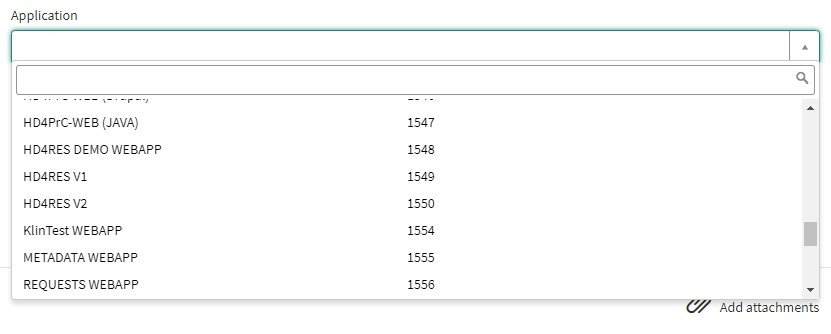
Please describe clearly and briefly (1 sentence) the subject of your problem.

Please describe in detail the problem. Following aspects are important for us to understand and to solve the problem:
- a description of the actions you want to perform but fail to accomplish (Ex: provide us field name, validation rule, button, etc.);
- a description (if possible) of the sequential steps you take to use the healthdata.be service or application you need support for;
- a brief description of the technical problem you are experiencing (e.g. error messages)

We highly recommend to add a screenshot describing the problem (IMPORTANT: do not provide us patient data!).
You can add the screenshot by pressing "Add attachments"
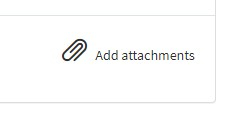
On the right side of the form, the required information elements of the Incident form are listed. When these fields are completed, these field names will disappear in the "required information" box.

Only if all required fields are completed , a form can be submitted., by pressing the green "Submit" button.

If not all required fields were completed, a warning message will appear on top of the form.

Also, the missing required fields will be highlighted in green.

When the incident form was successfully submitted, an overview of your submission will appear in an new screen.
On the right of the screen, you will find the details , including the Incident number.
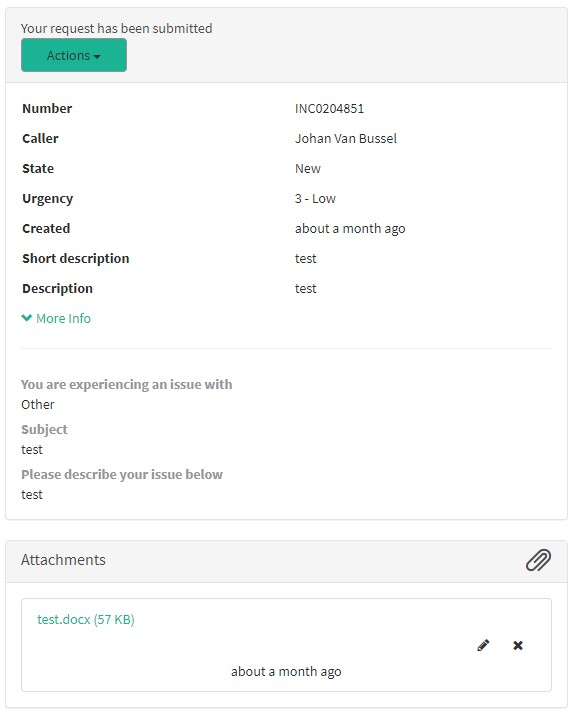
On the left of the screen, you will find a timeline of the handling your incident, starting with your creation.

This documentation is being updated regularly. We try to provide as correct, complete and clear as possible information on these pages. Nevertheless, if you see anything in the documentation that is not correct, does not match your experience or requires further clarification, please create a request (type : request for information) via our portal (https://sciensano.service-now.com/sp) or send us an e-mail via support.healthdata@sciensano.be to report this documentation issue. Please, do not forget to mention the URL or web address of the page with the documentation issue. We will then adjust the documentation as soon as possible. Thank you!Submit a request for information about HD4RES v2
Submit a request for information about HD4RES v2To request information about the HD4RES v2 component of the healthdata.be platform, you first need to log in to the HD Service and Support portal: https://sciensano.service-now.com/sp.
After te login step, you will arrive at the main page of the portal.

On the main page select "Request something".

A new page with the different types of request will appear.

Select the box "Request for information about HD".
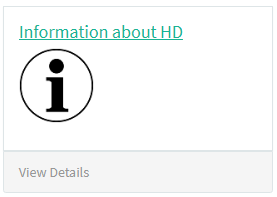
A new page with the titles of the Request for information about HD will appear.
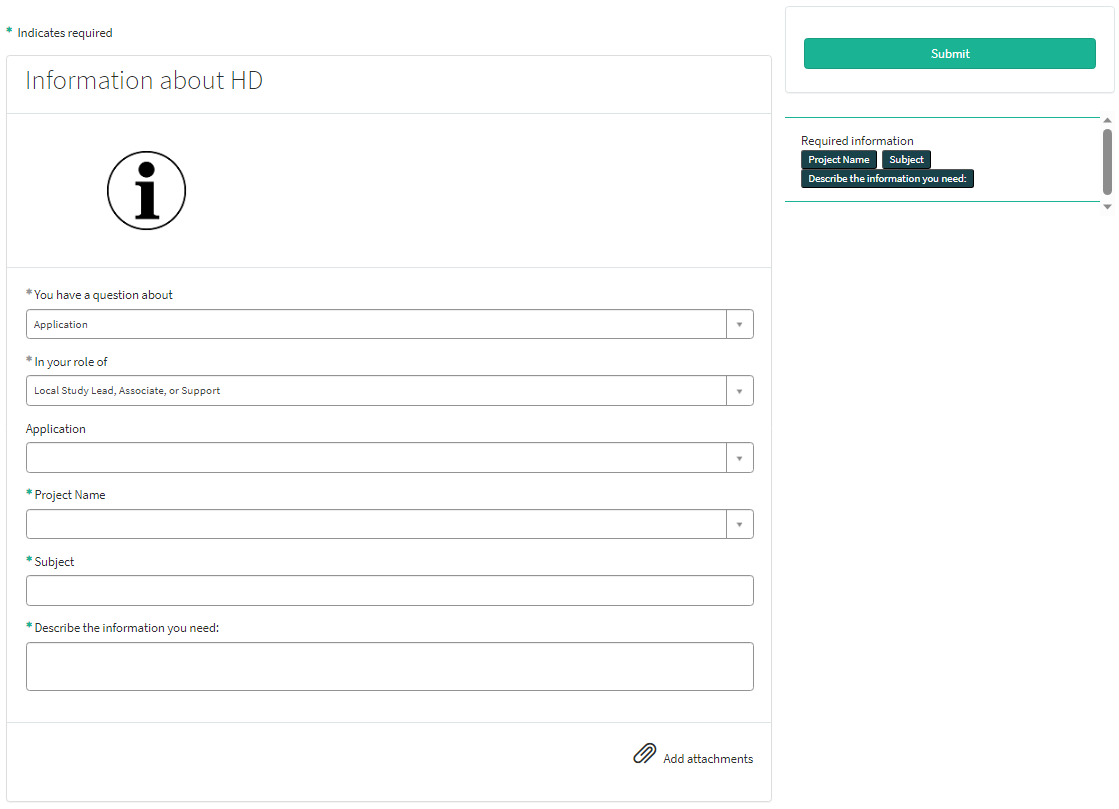
You can now document your request by providing following information:
Provide a short and clear description of your request for information (1 sentence).

Provide a detailed description of your request for information.

If available, please upload additional documents relevant for this request for information about HD.

On the right side of the form, the required information elements of the request form are listed. When these fields are completed, these field names will disappear in the "required information" box.

Only after all required fields have been completed, a form can be submitted by selecting the green Submit button.

If not all required fields were completed a warning message will appear on top of the form.

Also the missing required fields will be highlighting in green.

When the request form was successfully submitted, an overview of your request will appear in a new screen.
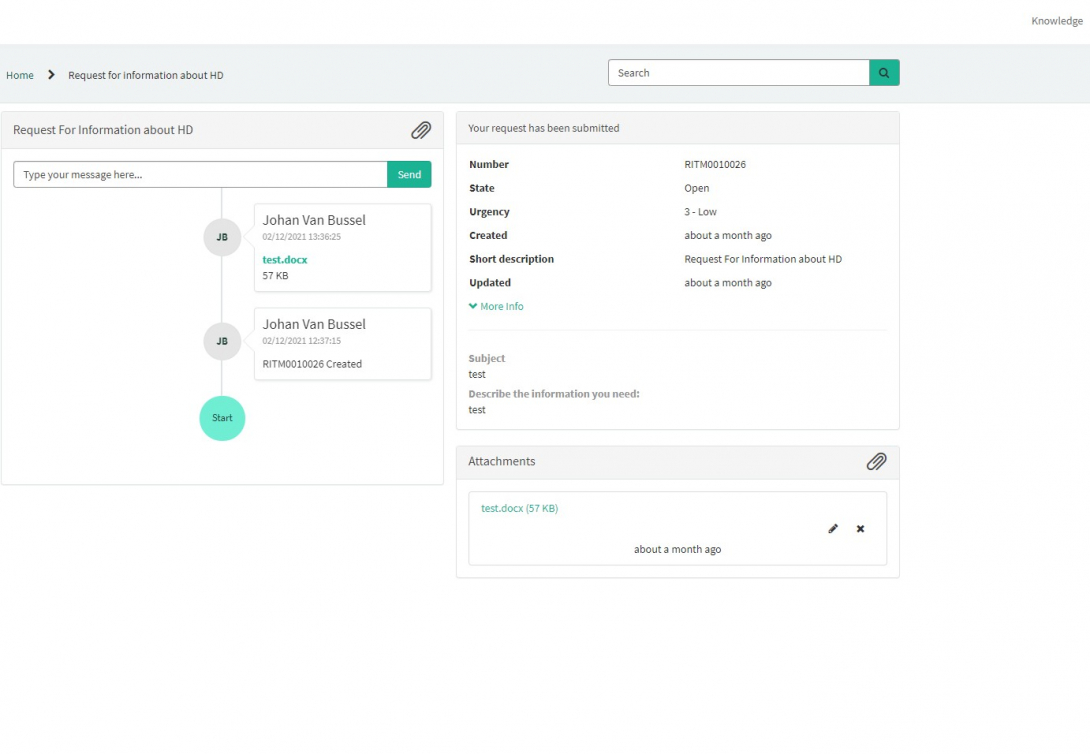
On the right of the screen, you will find the details , including the Request number

On the left of the screen, you will find a timeline of the handling your request, starting with your creation.
